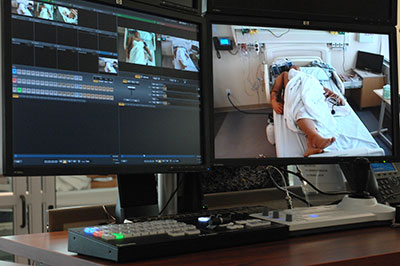C-Level View | Feature
Immersive Health Education From a Distance
Telepresence and simulation technologies offer remote learners the real thing in training for patient care.

Modesto Junior College and Columbia College provide health professional education using telepresence and simulation technologies. (Photo courtesy of Modesto Junior College and Yosemite Community College District) |
The Yosemite Community College District covers an area of 4,500 square miles, serving six California counties. Given the huge distances involved, it's no surprise that its two colleges are blazing the trail for better access to education through telepresence and simulation technologies. Modesto Junior College, in the heart of the state's Central Valley, recently updated its telepresence offerings beginning with its flagship nursing program, which connects MJC to Columbia College classrooms in the Sierra foothills.
Mel Ainsworth, who works on the project in MJC's IT department, explains how immersive telepresence technologies are bringing high-end instruction to health-profession learners in the remote communities of Tuolumne County.
CAMPUS TECHNOLOGY: Didn't your institution already have teleconferencing programs?
MEL AINSWORTH: Yes, but there were some serious limitations, and it was time to update. Part of a large building bond was spent constructing a new allied health nursing building in Modesto, which presented an opportunity to upgrade the entire technology infrastructure. As a result, there's been a major improvement in telepresence services to our classrooms.
CT: Can you describe some of the new technology you've deployed?
AINSWORTH: Last semester was our shakedown term after getting the systems up and running. The central technology is Cisco Show and Share, but there are several additional components, including highly flexible in-room camera environments, along with recording and media-management tools. High-definition video, in particular, has enabled us to make significant upgrades in the quality of instruction we can offer at a distance.
Our Human Patient Simulation Labs have life-sized, responsive, and interactive manikins with embedded sensors, WiFi access points, and simulated telemetry. We have built four full-size mock-up hospital rooms with multiple cameras, microphones, speakers, and LCD displays in addition to standard hospital equipment. Nursing students work on a variety of simulated scenarios that they would face in hospitals, and instructors can review and critique recordings of a student's performance in this "real world" environment.
CT: How does all this affect YCCD's plans for future programs?
AINSWORTH: Our new telepresence system has become integral to our remote programs, and high-end telepresence is now embedded in our allied health nursing program. We're excited about extending our services in areas like mobile devices, live streaming, selected closed captioning, lecture capture and distribution, and recording and publishing instructional tools.
We also find very active interest on the part of other departments, divisions, and colleges. Just this semester, we added a receiver site at MJC for Psych Tech training: A cohort of students in Modesto is "added" into a class at West Hills College Coalinga, and the instructor in Coalinga interacts with the Modesto cohort along with her local class via telepresence. Further, we are exploring the potential for refreshment programs for working health professionals.
We expect to see many more telepresence applications throughout YCCD in the future. We are living in a telepresence age. The environment we've invested in shows real promise for the needs we see coming down the road.
Editor's note: Mel Ainsworth will present a breakout session, "Reaching New Students Through Telepresence Technology," at CT Forum 2013 in San Diego, April 29-May 1.
About the Author
Mary Grush is Editor and Conference Program Director, Campus Technology.

